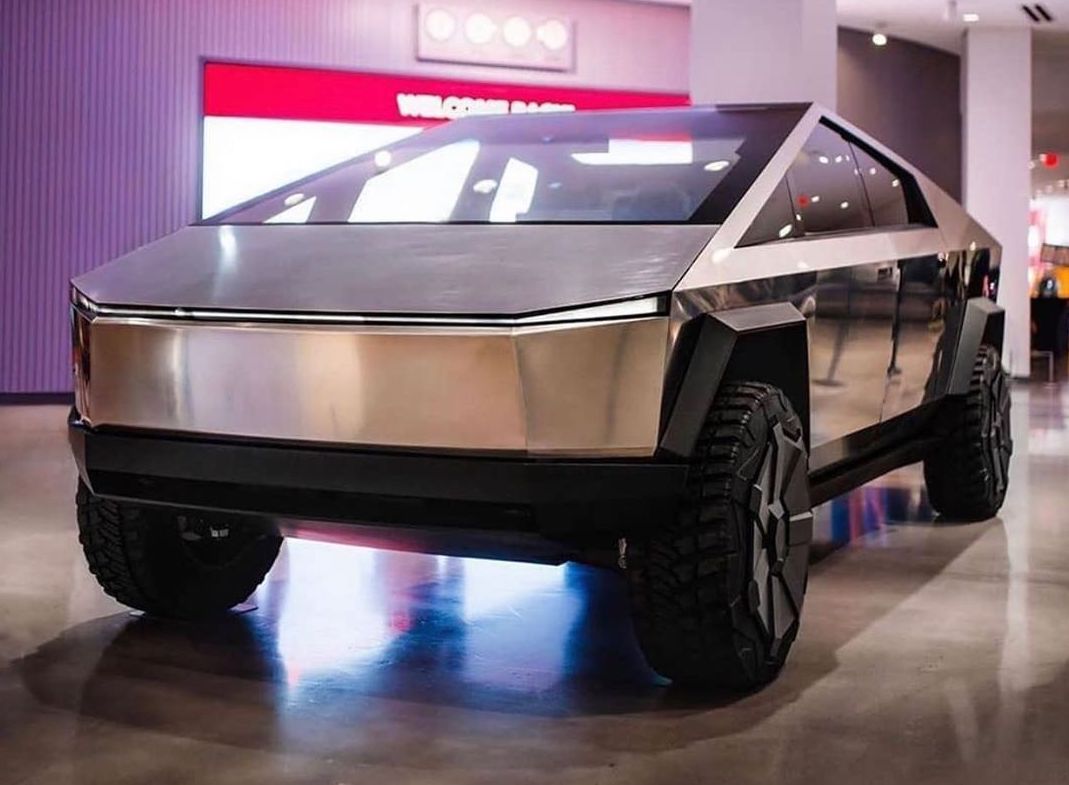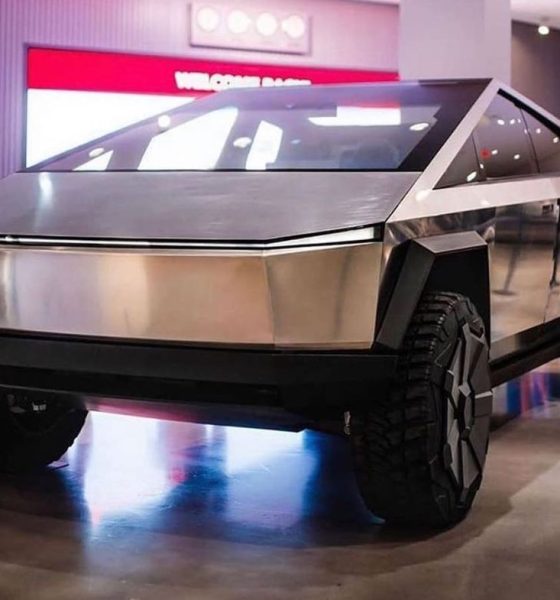

News
The Cybertruck is now the cheapest Tesla that customers could order today
Tesla tends to roll out price increases and decreases to its vehicle lineup on a rather frequent basis. Just recently, Tesla rolled out new price adjustments to the Model 3 and Model Y, which resulted in the Model 3 Standard Range Plus — the most affordable vehicle in the company’s currently available lineup — now starting at about $42,000 before incentives. This recent round of price increases also had another effect: it made the base Cybertruck the cheapest Tesla that could be ordered today.
Tesla CEO Elon Musk incited some strong reactions during the Cybertruck’s unveiling when he revealed that the massive all-electric pickup truck’s base variant, which uses one electric motor and an RWD configuration, would start at $39,990 before incentives. This was quite shocking considering the Cybertruck’s size, as well as Musk’s previous statement during an appearance at the Ride the Lightning podcast which pointed to the all-electric truck starting “well under $50,000.”

Needless to say, very few could have predicted then that Elon Musk’s “well below $50,000” teaser meant that the Cybertruck would start at $39,990. At that price, the hulking steel pickup truck found itself at the same range as the base Model Y, which was announced with a starting price of $39,000. The Model Y Standard Range was briefly made available in the United States for $41,990 before it was discontinued, but it has since been released in China at a price of about $42,800.
Interestingly enough, Tesla’s price adjustments have now reached a point where even the Model 3 Standard Range Plus, which has long been the company’s most affordable vehicle, is now more expensive than the Single-Motor Cybertruck. This meant that those who wish to make a reservation for Tesla’s current vehicle offerings would find the base Cybertruck as their most affordable option, for now at least.
And considering that Tesla has not updated the Cybertruck’s order page, it appears that the company does not see a need to adjust its all-electric pickup truck’s starting price just yet. That being said, Tesla’s terms and conditions in the Cybertruck’s Motor Vehicle Pre-Agreement do state that the final cost of the all-electric pickup truck may be subject to changes when the vehicle enters production. Placing orders for the Cybertruck would then lock in the cost of FSD, but not necessarily the $39,990 price for the pickup’s base variant.
Tesla would likely start the Cybertruck’s production with the vehicle’s more expensive trims, such as the Tri-Motor AWD and Dual-Motor AWD variants, which are priced at $69,990 and $49,990, respectively. The company is also evidently counting on some of its innovations to keep the Cybertruck’s cost as low as possible, such as the upcoming 4680 cells and structural battery packs. If Tesla’s 4680 cells remain delayed, however, or if the company is unable to master the Cybertruck’s megacasted parts, then it would not be a surprise if the pickup truck’s most affordable variants end up starting substantially above $39,990.
Don’t hesitate to contact us with news tips. Just send a message to tips@teslarati.com to give us a heads up.

News
Tesla starts showing how FSD will change lives in Europe
Local officials tested the system on narrow country roads and were impressed by FSD’s smooth, human-like driving, with some calling the service a game-changer for everyday life in areas that are far from urban centers.

Tesla has launched Europe’s first public shuttle service using Full Self-Driving (Supervised) in the rural Eifelkreis Bitburg-Prüm region of Germany, demonstrating how the technology can restore independence and mobility for people who struggle with limited transport options.
Local officials tested the system on narrow country roads and were impressed by FSD’s smooth, human-like driving, with some calling the service a game-changer for everyday life in areas that are far from urban centers.
Officials see real impact on rural residents
Arzfeld Mayor Johannes Kuhl and District Administrator Andreas Kruppert personally tested the Tesla shuttle service. This allowed them to see just how well FSD navigated winding lanes and rural roads confidently. Kruppert said, “Autonomous driving sounds like science fiction to many, but we simply see here that it works totally well in rural regions too.” Kuhl, for his part, also noted that FSD “feels like a very experienced driver.”
The pilot complements the area’s “Citizen Bus” program, which provides on-demand rides for elderly residents who can no longer drive themselves. Tesla Europe shared a video of a demonstration of the service, highlighting how FSD gives people their freedom back, even in places where public transport is not as prevalent.
What the Ministry for Economic Affairs and Transport says
Rhineland-Palatinate’s Minister Daniela Schmitt supported the project, praising the collaboration that made this “first of its kind in Europe” possible. As per the ministry, the rural rollout for the service shows FSD’s potential beyond major cities, and it delivers tangible benefits like grocery runs, doctor visits, and social connections for isolated residents.
“Reliable and flexible mobility is especially vital in rural areas. With the launch of a shuttle service using self-driving vehicles (FSD supervised) by Tesla in the Eifelkreis Bitburg-Prüm, an innovative pilot project is now getting underway that complements local community bus services. It is the first project of its kind in Europe.
“The result is a real gain for rural mobility: greater accessibility, more flexibility and tangible benefits for everyday life. A strong signal for innovation, cooperation and future-oriented mobility beyond urban centers,” the ministry wrote in a LinkedIn post.
News
Tesla China quietly posts Robotaxi-related job listing
Tesla China is currently seeking a Low Voltage Electrical Engineer to work on circuit board design for the company’s autonomous vehicles.

Tesla has posted a new job listing in Shanghai explicitly tied to its Robotaxi program, fueling speculation that the company is preparing to launch its dedicated autonomous ride-hailing service in China.
As noted in the listing, Tesla China is currently seeking a Low Voltage Electrical Engineer to work on circuit board design for the company’s autonomous vehicles.
Robotaxi-specific role
The listing, which was shared on social media platform X by industry watcher @tslaming, suggested that Tesla China is looking to fill the role urgently. The job listing itself specifically mentions that the person hired for the role will be working on the Low Voltage Hardware team, which would design the circuit boards that would serve as the nervous system of the Robotaxi.
Key tasks for the role, as indicated in the job listing, include collaboration with PCB layout, firmware, mechanical, program management, and validation teams, among other responsibilities. The role is based in Shanghai.
China Robotaxi launch
China represents a massive potential market for robotaxis, with its dense urban centers and supportive policies in select cities. Tesla has limited permission to roll out FSD in the country, though despite this, its vehicles have been hailed as among the best in the market when it comes to autonomous features. So far, at least, it appears that China supports Tesla’s FSD and Robotaxi rollout.
This was hinted at in November, when Tesla brought the Cybercab to the 8th China International Import Expo (CIIE) in Shanghai, marking the first time that the autonomous two-seater was brought to the Asia-Pacific region. The vehicle, despite not having a release date in China, received a significant amount of interest among the event’s attendees.
Elon Musk
Elon Musk and Tesla AI Director share insights after empty driver seat Robotaxi rides
The executives’ unoccupied tests hint at the rapid progress of Tesla’s unsupervised Robotaxi efforts.

Tesla CEO Elon Musk and AI Director Ashok Elluswamy celebrated Christmas Eve by sharing personal experiences with Robotaxi vehicles that had no safety monitor or occupant in the driver’s seat. Musk described the system’s “perfect driving” around Austin, while Elluswamy posted video from the back seat, calling it “an amazing experience.”
The executives’ unoccupied tests hint at the rapid progress of Tesla’s unsupervised Robotaxi efforts.
Elon and Ashok’s firsthand Robotaxi insights
Prior to Musk and the Tesla AI Director’s posts, sightings of unmanned Teslas navigating public roads were widely shared on social media. One such vehicle was spotted in Austin, Texas, which Elon Musk acknowleged by stating that “Testing is underway with no occupants in the car.”
Based on his Christmas Eve post, Musk seemed to have tested an unmanned Tesla himself. “A Tesla with no safety monitor in the car and me sitting in the passenger seat took me all around Austin on Sunday with perfect driving,” Musk wrote in his post.
Elluswamy responded with a 2-minute video showing himself in the rear of an unmanned Tesla. The video featured the vehicle’s empty front seats, as well as its smooth handling through real-world traffic. He captioned his video with the words, “It’s an amazing experience!”
Towards Unsupervised operations
During an xAI Hackathon earlier this month, Elon Musk mentioned that Tesla owed be removing Safety Monitors from its Robotaxis in Austin in just three weeks. “Unsupervised is pretty much solved at this point. So there will be Tesla Robotaxis operating in Austin with no one in them. Not even anyone in the passenger seat in about three weeks,” he said. Musk echoed similar estimates at the 2025 Annual Shareholder Meeting and the Q3 2025 earnings call.
Considering the insights that were posted Musk and Elluswamy, it does appear that Tesla is working hard towards operating its Robotaxis with no safety monitors. This is quite impressive considering that the service was launched just earlier this year.








